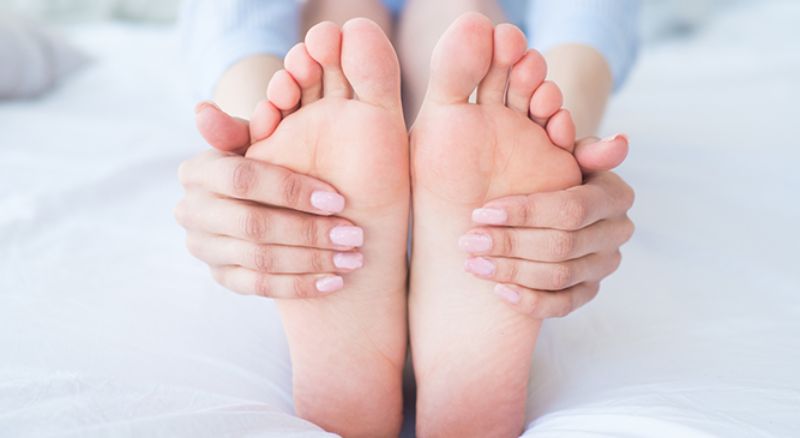For people with diabetes, proper foot care is essential. Nerve damage and reduced circulation, common complications of diabetes, can lead to a loss of sensation and increased risk of foot problems. This comprehensive guide empowers you to take charge of your foot health and prevent complications.
Why Foot Care Matters for Diabetics:
- Nerve Damage (Neuropathy): High blood sugar levels can damage nerves, leading to a loss of sensation in your feet. You might not feel cuts, blisters, or sores, increasing the risk of infection.
- Poor Circulation: Diabetes can restrict blood flow to the feet, making it harder for wounds to heal and increasing the risk of infection.
- Foot Deformities: Over time, diabetes can cause changes in the shape of your feet, making them more prone to pressure sores and other complications.
Taking Charge of Your Foot Health:
A proactive approach to foot care is crucial for preventing problems. Here’s a daily routine to follow:
- Daily Foot Inspection: Take a close look at your feet every day, checking for cuts, blisters, bruises, redness, swelling, ingrown toenails, or any other changes. Use a mirror if needed to see the bottoms of your feet.
- Wash Your Feet Daily: Use warm, soapy water to gently wash your feet. Dry them thoroughly, especially between the toes. Avoid soaking your feet for extended periods.
- Moisturize Dry Skin: Dry skin can crack and lead to infection. Apply a fragrance-free moisturizer to the tops and bottoms of your feet, but not between the toes.
- Trim Your Toenails Carefully: Cut your toenails straight across and avoid cutting them too short. If you have trouble seeing your feet or have poor circulation, consult a podiatrist (foot doctor) for nail care.
- Wear Proper Footwear: Choose well-fitting, comfortable shoes with good arch support and a wide toe box. Avoid tight shoes, sandals, or going barefoot. Inspect the insides of your shoes for any debris before putting them on.
Additional Tips for Optimal Foot Care:
- Manage Your Blood Sugar Levels: Keeping your blood sugar under control is the most important step in preventing foot complications.
- Control Blood Pressure: High blood pressure can further worsen circulation problems in the feet.
- Don’t Smoke: Smoking significantly restricts blood flow, increasing the risk of foot problems.
- Keep Your Feet Warm: Cold temperatures can reduce circulation. Wear warm socks in cold weather and avoid using hot water bottles or heating pads on your feet without proper supervision.
- See Your Doctor Regularly: Schedule regular foot exams with your doctor or podiatrist. They can check for any problems and provide early intervention if needed.
Common Diabetic Foot Problems and How to Spot Them:
- Foot Ulcers: Open sores on the bottom of the foot are a serious complication of diabetes. Signs include redness, swelling, pain, or pus drainage. Early detection and treatment are crucial to prevent infection and serious complications.
- Athlete’s Foot: A fungal infection causing itching, burning, scaling, and cracking of the skin, especially between the toes. Look for these symptoms and seek treatment if you suspect athlete’s foot.
- Ingrown Toenails: When the corner of a toenail grows into the skin, it can cause pain, redness, and swelling. If you have trouble managing your toenails due to poor circulation or nerve damage, consult a podiatrist.
- Calluses and Corns: These are thickened areas of skin that can develop due to friction from ill-fitting shoes. While not necessarily harmful, they can be uncomfortable. See a podiatrist for proper removal, especially if you have neuropathy.
Conclusion:
By prioritizing daily foot care, managing your blood sugar levels, and seeking professional help when needed, you can significantly reduce the risk of foot complications and maintain healthy feet for a lifetime. Remember, diabetic foot care is not just about pampering your feet – it’s about protecting your overall health and well-being. Take charge of your foot health and empower yourself to walk confidently towards a healthy future.

 Diabetology1 week ago
Diabetology1 week ago
 Diabetology6 days ago
Diabetology6 days ago
 Diabetology1 week ago
Diabetology1 week ago
 Diabetology1 week ago
Diabetology1 week ago
 Diabetology4 days ago
Diabetology4 days ago
 Diabetology4 days ago
Diabetology4 days ago
 Diabetology2 days ago
Diabetology2 days ago
 Diabetology2 days ago
Diabetology2 days ago












